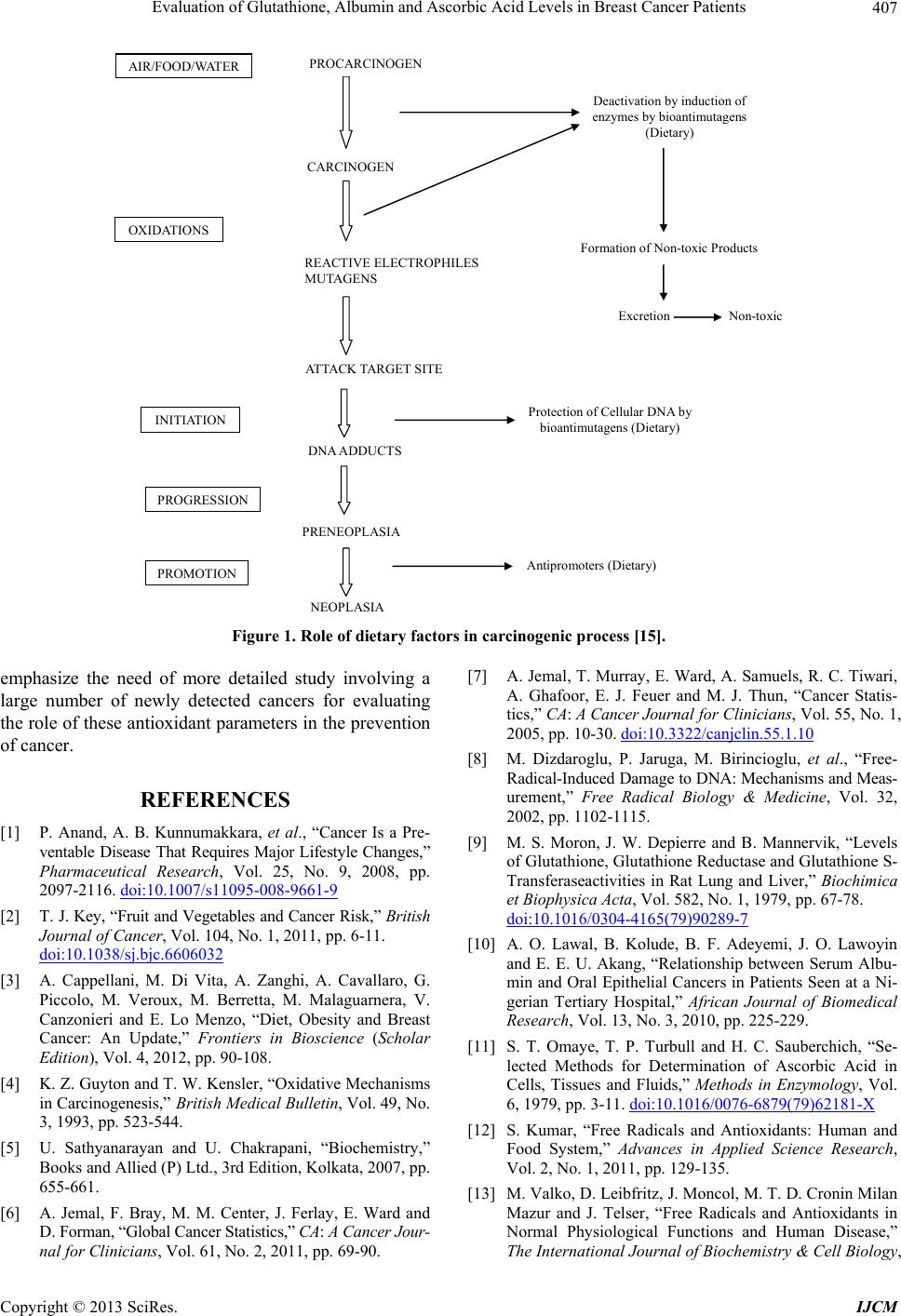
Evaluation of Glutathione, Albumin and Ascorbic Acid Levels in Breast Cancer Patients
Copyright © 2013 SciRes. IJCM
407
Formation of Non-toxic Products
Deactivation by induction of
enzymes by bioantimutagens
(Dietary)
CARCINOGEN
AIR/FOO D/WATER
PROCARCINOGEN
OXIDATIONS
REACTI VE ELECTROPHILES
MUTAGENS
Excretion Non-toxic
ATTACK TARGET SITE
Protection of Cellular DNA by
bioantimutagens (Dietary)
INITIATION
DNA ADDUCTS
PROGRESSION
PRENEOPLASIA
PROMOTION
Antipromoters (Dietary)
NEOPLASIA
Figure 1. Role of dietary factors in carcinogenic process [15].
[7] A. Jemal, T. Murray, E. Ward, A. Samuels, R. C. Tiwari,
A. Ghafoor, E. J. Feuer and M. J. Thun, “Cancer Statis-
tics,” CA: A Cancer Journal for Clinicians, Vol. 55, No. 1,
2005, pp. 10-30. doi:10.3322/canjclin.55.1.10
emphasize the need of more detailed study involving a
large number of newly detected cancers for evaluating
the role of these antioxidant parameters in the prevention
of cancer. [8] M. Dizdaroglu, P. Jaruga, M. Birincioglu, et al., “Free-
Radical-Induced Damage to DNA: Mechanisms and Meas-
urement,” Free Radical Biology & Medicine, Vol. 32,
2002, pp. 1102-1115.
REFERENCES
[1] P. Anand, A. B. Kunnumakkara, et al., “Cancer Is a Pre-
ventable Disease That Requires Major Lifestyle Changes,”
Pharmaceutical Research, Vol. 25, No. 9, 2008, pp.
2097-2116. doi:10.1007/s11095-008-9661-9
[9] M. S. Moron, J. W. Depierre and B. Mannervik, “Levels
of Glutathione, Glutathione Reductase and Glutathione S-
Transferaseactivities in Rat Lung and Liver,” Biochimica
et Biophysica Acta, Vol. 582, No. 1, 1979, pp. 67-78.
doi:10.1016/0304-4165(79)90289-7
[2] T. J. Key, “Fruit and Ve getables and Cancer Risk,” British
Journal of Cancer, Vol. 104, No. 1, 2011, pp. 6-11.
doi:10.1038/sj.bjc.6606032 [10] A. O. Lawal, B. Kolude, B. F. Adeyemi, J. O. Lawoyin
and E. E. U. Akang, “Relationship between Serum Albu-
min and Oral Epithelial Cancers in Patients Seen at a Ni-
gerian Tertiary Hospital,” African Journal of Biomedical
Research, Vol. 13, No. 3, 2010, pp. 225-229.
[3] A. Cappellani, M. Di Vita, A. Zanghi, A. Cavallaro, G.
Piccolo, M. Veroux, M. Berretta, M. Malaguarnera, V.
Canzonieri and E. Lo Menzo, “Diet, Obesity and Breast
Cancer: An Update,” Frontiers in Bioscience (Scholar
Edition), Vol. 4, 2012, pp. 90-108. [11] S. T. Omaye, T. P. Turbull and H. C. Sauberchich, “Se-
lected Methods for Determination of Ascorbic Acid in
Cells, Tissues and Fluids,” Methods in Enzymology, Vol.
6, 1979, pp. 3-11. doi:10.1016/0076-6879(79)62181-X
[4] K. Z. Guyton and T. W. Ke nsler, “Oxidative Mechanisms
in Carcinogenesis,” British Medical Bulletin, Vol. 49, No.
3, 1993, pp. 523-544. [12] S. Kumar, “Free Radicals and Antioxidants: Human and
Food System,” Advances in Applied Science Research,
Vol. 2, No. 1, 2011, pp. 129-135.
[5] U. Sathyanarayan and U. Chakrapani, “Biochemistry,”
Books and Allied (P) Ltd., 3rd Edition, Kolkata, 2007, pp.
655-661. [13] M. Valko, D. Leibfritz, J. Moncol, M. T. D. Cronin Milan
Mazur and J. Telser, “Free Radicals and Antioxidants in
Normal Physiological Functions and Human Disease,”
The International Journal of Biochemistry & Cell Biology,
[6] A. Jemal, F. Bray, M. M. Center, J. Ferlay, E. Ward and
D. Forman, “Global Cancer Statistics,” CA: A Cancer Jour-
nal for Clinicians, Vol. 61, No. 2, 2011, pp. 69-90.